Finger limes, or Australian native caviar, are a sought after caviar like fruit in many kitchens. These delectable finger lime fruits offer a fantastic burst of flavour in dishes and can even be grown at home.
These attractive trees have long been an essential food source for indigenous communities but also offer wonderful landscaping opportunities for home gardens.
Considering growing Australian finger lime in your garden? Here is everything you need to know to cultivate, care for and grow wonderfully fruiting finger limes.
More...
Family: | Rutaceae |
|---|---|
Genus: | Citrus |
Species: | C. australasica |
Previous Name: | Microcitrus australasica |
Common Names: | Finger lime, Australian finger lime, lime caviar, native finger lime, bush lime tree, caviar lime tree |
Location: | Outdoor |
Type: | Large shrub to small tree |
Growth: | 2 to 7 metres tall, 2 to 5 metres wide |
Sun requirements: | Full sun to light shade |
Foliage Colour: | Green |
Flower Colour: | White |
Flowering: | Spring |
Fruit: | Edible cylindrical fruits in summer to autumn |
Maintenance level: | Low |
Poisonous for pets: | Toxic to cats and dogs |
What are Australian Finger Limes?
Finger limes, a native citrus species, are found growing naturally amongst most tropical and subtropical regions across Queensland and New South Wales. Due to the fantastically citrus flavour of the caviar like fruits, they’re a very popular choice for professional chefs and home cooks. However, these larger growing trees also offer some dense and beautiful foliage.
Each fruit produces lots of little caviar looking pods which can be enjoyed fresh, as a topping on a meal or as part of a desert. However, not every finger lime fruit looks and tastes the same. The little pods may range in colour from very light yellow, green and pink.
Some of the Most Popular Finger Lime Varieties

Citrus australasica ‘Pink Ice’
This gorgeous cultivar was one of the first commercialised varieties of finger lime. It is a medium-sized shrub that produces red to burgundy-coloured fruits with clear to pink pearls of plump juices inside.
Finger lime fruit smell very similar to ruby grapefruit so they make for excellent additions to cocktails, drinks and many culinary dishes in the kitchen. Perfect for container growing in warm courtyards, this smaller-growing variety reaches about 4 to 6 metres in height with a spread of around 1.5 to 2 meters.
Citrus australasica ‘Crimson Tide’
This is an even smaller-growing variety that reaches up to 1.5 metres tall and wide. It produces black to dark-brown fruits with attractive red-coloured caviar-like vesicles inside.
It is considered one of the slowest-growing varieties that produces less prolific harvests than others but the fruits are also considered some of the tastiest as well. Unfortunately, this specific variety can be hard to come by.
Citrus australasica ‘Chartreuse’
This variety is renowned for its tasty fruits that have a subtle citrus flavour. The fruits are also less bitter than other finger limes so this plant is a great choice for those who don’t enjoy overly bitter fruits.
It produces pale green to yellowy fleshed fruits with clear to lime green coloured vesicles inside. This plant will usually reach 2 to 5 metres tall and 2 to 3 metres wide in cultivation.


Get Your Free Guide:
Master Growing Australian Natives eBook
A Must Have Complete Guide for Every Australian Garden
Get Your Free Guide:
Master Growing Australian Natives eBook
A Must Have Complete Guide for Every Australian Garden
Citrus australasica ‘Red Champagne’
Being the most popular variety of finger lime, Red Champagne fruits feature milder, more subtle flavour profiles that are perfect for many cooking applications. The fruits are black to maroon when mature with clear to light-red vesicles inside.
Fruits from this variety can even be eaten fresh and they have one of the longest shelf lives of all finger limes. It features an attractive dense canopy once established and is easily managed when grown in pots as it only reaches about 1.8 metres tall and wide.
How to Grow Finger Limes in Australia
The finger limes grows fairly throughout most parts of Australia and is even suitable for container growing. Naturally, finger lime trees will grow as big as 5 metres in height. However, in a pot, it will be significantly less.
Although accustomed to Australian conditions, there are a few aspects you will need to consider to ensure a large and fruitful harvest each year.
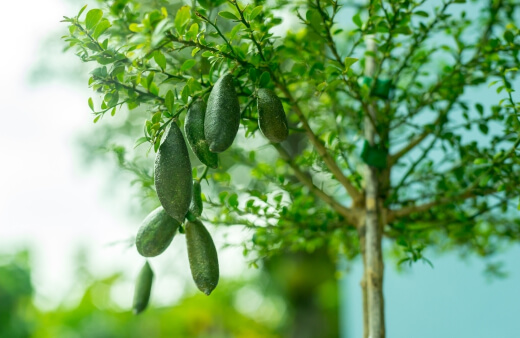
Choosing the Proper Location
Due to a large number of thorns present, your finger lime fruit can be damaged quite significantly if grown in areas that receive strong winds. As such, it is recommended to plant your finger lime tree in an area that is largely wind-free.
More so, Australian finger lime needs a consistent stream of dappled light to bear fruit. In cooler regions, a partly shaded north-facing position that gets a few good hours of full sun each day is ideal. In hotter climates, position in a location that gets more filtered shade to reduce the risk of sunburn.
It’s also essential to give your roots plenty of space to grow. So, when growing in soil, avoid overcrowding with too many other plants.
Ideal Soil for Bush Lime Tree
Bush lime tree is a citrus tree, and as such, you will need to find a rich, citrus specific soil mix. Soil needs to be quite rich and still well-draining. An average PH balance between 6 and 7 is also recommended.
Supplementing the soil with a slow-release fertiliser every 2 or 3 months will also be beneficial. For plants grown in the garden, enrich the soil with some compost and well-rotted manure before planting.
Ideal soil types are heavier, well-draining soils including loamy, sandy-loam or clay-loam soils.
Tips for Growing Finger Limes in Pots
Growing finger limes in a pot or large container is especially important in colder areas. When the frosts begin, you can move this native citrus to a warmer, sunnier location to ensure it doesn’t freeze in the winter.
There are also many other benefits of growing finger limes in pots:
- You can maintain the correct soil pH level far easier
- It is easier to ensure good drainage in containers
- You can protect your plant from harsh elements when needed by simply moving it
- Harvesting ripe fruits on time is easy when the tree is grown in containers
- It is easier to control the size of your finger limes in containers
- Pests and disease issues are less severe
Here are some other helpful tips for growing this native citrus in pots:
- Be sure to use a pot or container that is at least more than twice as wide as the root ball of the plant
- Use a premium quality potting mix or citrus-specific mix for the best results
- Your planting hole should be at least twice as wide and to the same depth as the existing root ball.
- Mulching around the base of your plant with an organic mulch can help to ensure proper moisture, especially in container-grown trees.
- Place a small bed of pebbles or clay marbles at the bottom of the pot or container to ensure excellent drainage
- It is highly recommended to repot your finger lime tree every 2 to 3 years in spring and add fresh soil each time
Propagating Finger Limes
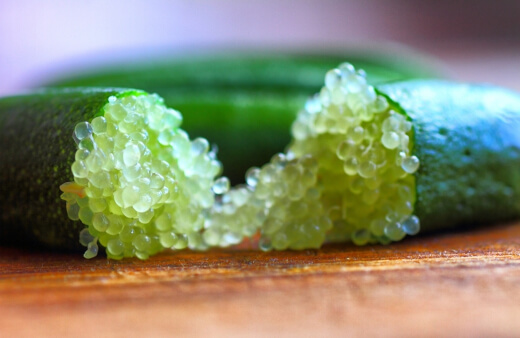
Propagation of finger limes can be done via seed, cutting or graft. Unfortunately, propagation from seed is very slow, and it can take as long as 15 years for seeds to reach maturity.
It’s also important to use very fresh seeds as they do not maintain viability for very long. Semi-hardwood cuttings can be a successful method. Although, it does also take some special care and attention.
As such, most gardeners will recommend purchasing a young finger lime tree from your local garden centre or nursery. These grafted varieties found in-store are far easier to maintain and grow at home and they will also produce fruits far sooner.
How to Take Care of Your Caviar Lime Tree
Caviar lime tree does require regular care and maintenance for an ideal fruit yield. You will need to regulate general conditions to ensure your finger limes are getting enough water, your soil is draining properly and that the inner leaves are receiving enough light to photosynthesize properly.
For container growing, it is recommended to re-pot your caviar lime tree every 2 or 3 years to keep the soil fresh and filled with nutrients.
When it comes to watering, potted finger limes will dry out far quicker than those planted in soil. As a rule of thumb, check general moisture every 2 to 3 days if the soil feels dry, water.
Should You Prune Finger Limes?
Pruning is an important part of maintenance for this native citrus, which will encourage fruit growth and maintain tree shape. Take extreme care to use a decent pair of loppers and wear a pair of gloves, as the many thorns can become a large hazard.
Pruning should be done after harvesting to encourage growth for the next season. Take care to remove any damaged or old wood and clear the inner branches to allow light to reach everywhere it needs to.
Light pruning should also be done when the tree is young after flowering to encourage an open shape with about 4 to 6 main branches.
Protecting Your Bush Lime Tree's Flowers & Fruit
The finger lime produces gorgeous white and pink flowers throughout the year. These are very powerful pollinators and may attract many honeybees and other pollen feeders to your garden.
Your caviar lime tree will only begin to bear fruit 3 to 5 years after planting. The first two fruiting seasons will likely be a very low harvest. However, this will pick up after the second fruiting season.
Fruits come in colours of green, yellow, black, purple and red.
How to Harvest Finger Limes
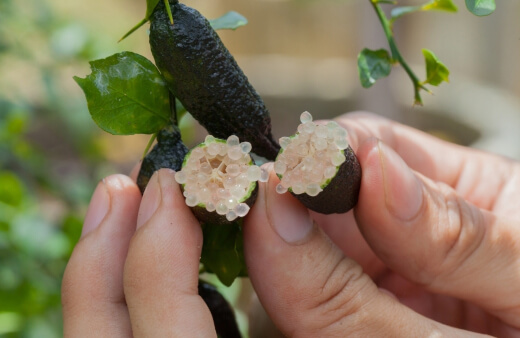
In the right conditions, citrus caviar fruits will begin to drop of their own accord, usually between the months of November and March. It’s important to wait until the fruits have matured before harvesting, as they will not continue to mature once removed from the branches.
You can keep your tree base well mulched to encourage a natural fruit drop or tug gently at the fruits. If mature, they should come off fairly easily. Take care not to damage the fruits in the removal process.
Possible Finger Lime Pests & Diseases to Look Out For
Finger lime tree is a natural host of the citrus gall wasp. These pesky insects will reduce the size and quality of your fruit yield if left unattended.
To prevent citrus gall wasps nesting in your citrus caviar trees, you’ll want to:
- Regularly check your finger lime tree branches between January & September.
- Remove and Burn any infected branches immediately. Do not leave removed branches on a compost heap.
- Use commercial wasp repellent traps.
Other pests which may be drawn to your finger lime tree include:
- Crusader Bugs
- Spined Citrus Bugs
- Caterpillars
- Grasshoppers
- Aphids
- Mealybugs
Australian Finger Lime Dieback & Defoliation
Finger limes that are placed under too much stress can suffer from some unwanted issues like branch dieback and defoliation. These problems will quickly cause your finger lime tree to look unhealthy and unattractive.
Container-grown plants are more susceptible to dieback and defoliation. Dieback will mostly affect the branches where they will begin wilting and browning.
Even if they do still show some green growth in branch tips, browning sections of branches is not ideal as these trees can photosynthesize all the way down the stems. Shedding leaves or defoliation will usually occur alongside branch dieback.
Common causes of these issues include:
- A lack of soil drainage
- Frost injury
- Very hot or cold winds
- A lack of adequate exposure to the sunlight
- General neglect
Here are some helpful ways you can combat branch dieback and defoliation:
- Ensure your soil retains a healthy amount of moisture but always remains free-draining
- Ensure your soil never fully dries out between waterings
- Repot your finger lime into fresh soil and add a decent amount of coconut coir to the mix to ensure proper drainage.
- Move the tree to a brighter location with some afternoon shade
- Be sure not to over fertilise your tree and always feed with a fertiliser that is a little lower in nitrogen
- Prune away any dead or damaged branches to ensure proper amounts of light are reaching all parts of the tree
- Finger limes are known to resprout the following season after losing leaves so give your tree a little extra TLC and it should bounce back next season
Cooking with Finger Lime
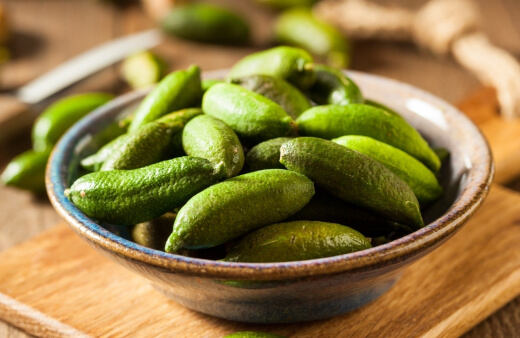
Finger limes are nibble ready from harvest, but you can also add them to a wide range of dishes. Not only do they look fancy, but they’re delicious too.
You can use finger limes as a topping for salads, canapes and ice creams, as a citrus element for Tex-Mex meals, on Seafood, Sushi, Poultry and any other white meat that pairs well with citrus. Check out these fantastic finger lime recipes.
Frequently Asked Questions About Finger Limes
Can you eat finger limes raw?
You can eat finger limes raw and cooked, but they have their zestiest, freshest, and most unique flavour when used raw, either by scattering the zingy capsules over salads or desserts or even freezing and using as tiny, sour, ice cubes in cocktails.
Raw finger limes have a fresher flavour, but they can be cooked, or even zested to add flavour to cooked food too.
What do Aboriginals use finger lime for?
Indigenous Aboriginals use the native finger lime as a food source. They are foraged commonly throughout tropical jungles and used for their tangy pulp. The small pearls are also thought to have medicinal uses as antiseptic treatments, but other uses are not generally accepted in medical science.
How long do finger limes last?
Finger limes don’t keep for as long as regular limes, because their flavour and texture are all about the juicy little capsules. Regular limes keep for around a month in cool conditions, but finger limes only keep for a maximum of three weeks before their firm, juicy texture reduces, and the flavour with it.
For longer storage, freeze finger limes whole, or squeeze the capsules onto a tray to freeze them, before storing them in an air-tight freezer bag.
Why does my finger lime not fruit?
The most common cause of finger limes not fruiting is age. They take between six to ten years to really get into the swing of fruiting and will stall again when planted in a new location. So patience really is a virtue.
However, if you have a mature finger lime tree, and it is failing to produce ripe fruit, it is often the result of underwatering. Paired with good drainage, regular watering and feeding will massively boost your harvest.
What does a finger lime taste like?
Finger limes are bitter thanks to the presence of citric acid. They are citrus fruit after all. There is also a distinct herbal flavour unlike normal limes, and different varieties have distinct flavour notes too.
For example ‘Crimson Tide’ is a particularly sweet cultivar, and ‘Champagne’, named for the bubbles no doubt, is perfumed, sweet, and herbal.
Do you eat the skin of finger limes?
The skin of finger limes is not usually eaten but it isn’t toxic. However, like lemon zest, lime zest, or orange peel, the astringent flavour of finger lime skin is puckeringly sour and quite hard to handle. It is best used as a flavour enhancer, stirred through curry sauces and scooped out before serving, rather than eaten by itself.When do finger limes fruit?
It depends on your climate, the variety or cultivar you’re growing and the specific growing conditions. Most finger lime fruits will mature between December and May with the bulk of the harvest period occurring between March and May.
Once your citrus caviar fruits can be easily picked from the branches without resistance, you will know they are ripe and ready.
Where do finger limes grow?
These luscious fruiting trees occur naturally along the east coast of Australia where they can be found growing prolifically around the border of New South Wales and Queensland.
When to pick finger limes?
Only harvest fruits that have fully matured and ripened as fruits picked from the tree can’t ripen any further. Fully ripe fruits will feel firm to the touch and detach from the branches easily.
Usually, with most varieties, the skin of the fruits will also change colour. Main harvests will normally be around March to May each season.
How long do finger lime trees take to fruit?
Grafted finger limes, like the ones available from nurseries or garden centres, can begin fruiting in year, with the largest quantities of fruit occurring around year 6 and onwards.
Trees grown from seeds, seedlings or cuttings can take up to 15 years to produce good fruit harvests, depending on the cultivar or variety.
When are finger limes in season?
The typical finger lime seasons will start around mid-July and run until late December to early January.
What is the best tasting finger lime?
The ‘red champagne’ and ‘crimson tide’ varieties are known to taste the sweetest and produce the most palatable and versatile fruits.
Watch our YouTube video about growing Australian finger limes:
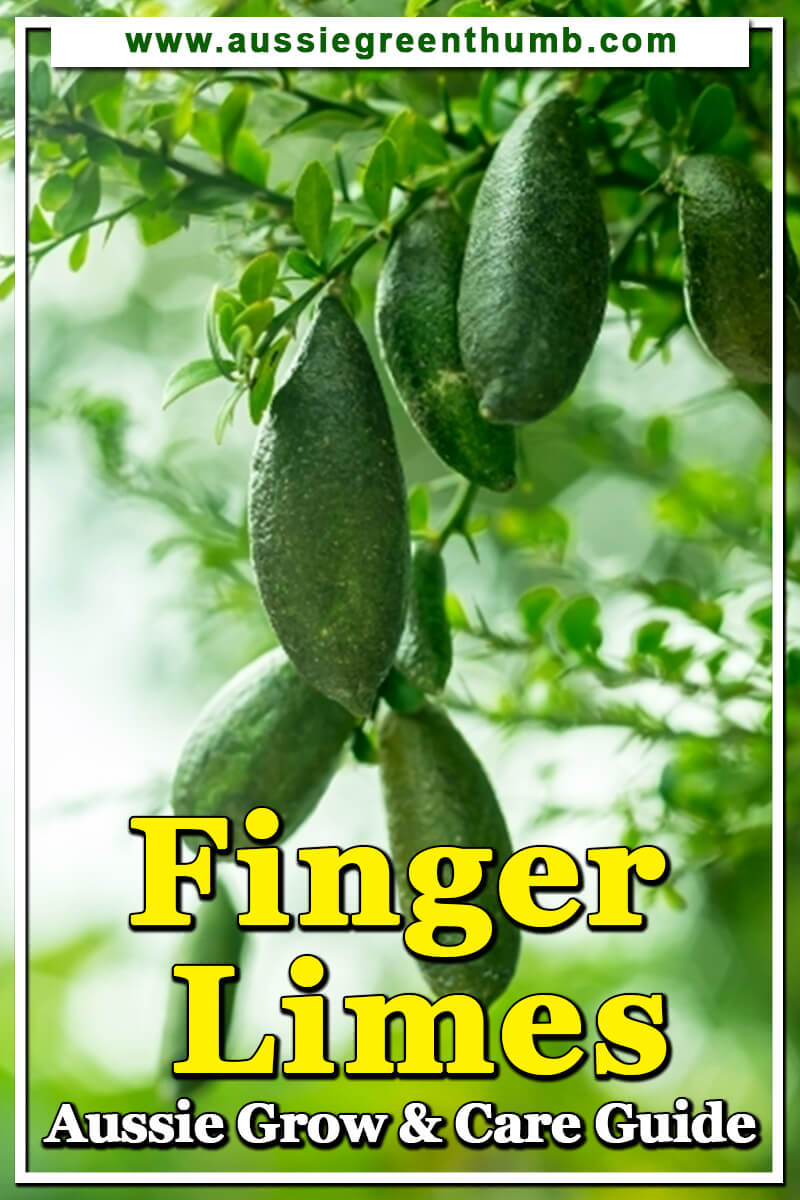
Australian Finger Limes - A Gardening Must
Yes, growing finger limes in your garden really is a great idea as long as you take extreme care around their thorns. Be sure to regularly check the level of moisture in the soil and the branches for any pesky invaders. You are all set to start growing finger limes.
Published on by Nathan Schwartz
Last Updated on January 25, 2025




